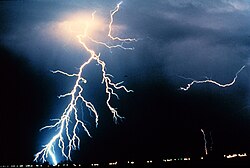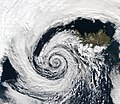
Back بوابة:طقس Arabic دەروازە:کەشوھەوا CKB Portál:Meteorologie Czech Portal:Wetter und Klima German Portail:Météorologie French Portale:Meteorologia Italian Portal:気象と気候 Japanese 포털:날씨 Korean Portāls:Meteoroloģija Latvian/Lettish Portal:Pogoda Polish
The weather portal
Weather is the state of the atmosphere, describing for example the degree to which it is hot or cold, wet or dry, calm or stormy, clear or cloudy. On Earth, most weather phenomena occur in the lowest layer of the planet's atmosphere, the troposphere, just below the stratosphere. Weather refers to day-to-day temperature, precipitation, and other atmospheric conditions, whereas climate is the term for the averaging of atmospheric conditions over longer periods of time. When used without qualification, "weather" is generally understood to mean the weather of Earth.
Weather is driven by air pressure, temperature, and moisture differences between one place and another. These differences can occur due to the Sun's angle at any particular spot, which varies with latitude. The strong temperature contrast between polar and tropical air gives rise to the largest scale atmospheric circulations: the Hadley cell, the Ferrel cell, the polar cell, and the jet stream. Weather systems in the middle latitudes, such as extratropical cyclones, are caused by instabilities of the jet streamflow. Because Earth's axis is tilted relative to its orbital plane (called the ecliptic), sunlight is incident at different angles at different times of the year. On Earth's surface, temperatures usually range ±40 °C (−40 °F to 104 °F) annually. Over thousands of years, changes in Earth's orbit can affect the amount and distribution of solar energy received by Earth, thus influencing long-term climate and global climate change.
Surface temperature differences in turn cause pressure differences. Higher altitudes are cooler than lower altitudes, as most atmospheric heating is due to contact with the Earth's surface while radiative losses to space are mostly constant. Weather forecasting is the application of science and technology to predict the state of the atmosphere for a future time and a given location. Earth's weather system is a chaotic system; as a result, small changes to one part of the system can grow to have large effects on the system as a whole. Human attempts to control the weather have occurred throughout history, and there is evidence that human activities such as agriculture and industry have modified weather patterns.
Studying how the weather works on other planets has been helpful in understanding how weather works on Earth. A famous landmark in the Solar System, Jupiter's Great Red Spot, is an anticyclonic storm known to have existed for at least 300 years. However, the weather is not limited to planetary bodies. A star's corona is constantly being lost to space, creating what is essentially a very thin atmosphere throughout the Solar System. The movement of mass ejected from the Sun is known as the solar wind. (Full article...)
Selected article

Hurricane Dean was the strongest tropical cyclone of the 2007 Atlantic hurricane season. A Cape Verde-type hurricane that formed on August 13, 2007, Dean took a west-northwest path from the eastern Atlantic Ocean through the Saint Lucia Channel and into the Caribbean. It strengthened into a major hurricane, reaching Category 5 status on the Saffir–Simpson hurricane scale before passing just south of Jamaica on August 20. The storm made landfall on the Yucatán Peninsula on August 21 as a powerful Category 5 storm. It crossed the peninsula and emerged into the Bay of Campeche as a weaker storm, but still at hurricane strength. It intensified briefly before making a second landfall near Tecolutla, Mexico, on August 22. Dean drifted northwest, weakening into a remnant low which dissipated over the southwestern United States.
The hurricane's intense winds, waves, rains and storm surge were responsible for at least 45 deaths across ten countries, and caused estimated damages ofUS$1.5 billion. Dean's path through the Caribbean devastated crops, particularly those of Martinique and Jamaica. Upon reaching Mexico, Hurricane Dean was a Category 5 storm—the third-most intense Atlantic hurricane at landfall in recorded history. However, it missed major population centers, so it caused no deaths and less damage than its passage through the Caribbean islands as a Category 2 storm.
Dean was the first hurricane to make landfall in the Atlantic basin at Category 5 intensity in 15 years; the last storm to do so was Hurricane Andrew on August 24, 1992. Dean's landfall was far less damaging than Andrew's, but its long swath of damage earned its name retirement from the World Meteorological Organization's Atlantic hurricane naming lists.
Recently selected articles: Weather forecasting, Climate of India, More...
Did you know (auto-generated) -

- ... that Come In was recorded on a hands-free microphone attached to a pair of headphones?
- ... that an attempted British-Norwegian attack on the German battleship Tirpitz was abandoned after two Chariot manned torpedoes were lost due to bad weather?
- ... that Richard Davis made the earliest known continuous land-based weather recordings in New Zealand?
- ... that environment minister Peng Chi-ming drafted Taiwan's first weather insurance policy?
- ... that the Quad Cities forecast office of the National Weather Service has been directly struck by both an F1 tornado and a historic derecho?
- ... that after Irish post office clerk Maureen Flavin Sweeney reported worsening weather conditions, Dwight D. Eisenhower agreed to postpone D-Day by 24 hours?
Selected image

A roll cloud off the coast of Punta del Este, Uruguay. Roll clouds are formed by strong outflow from a thunderstorm forcing surrounding air upwards.
Recently selected pictures: Hoar frost, Snowflakes, Ground fog, More...
More did you know...
...that the Flying river is the name given to the transport of water vapor from the Amazon rainforest to southern Brazil?
...that hurricane shutters are required for all homes in Florida unless impact-resistant glass is used?
...that the Joint Institute for Marine and Atmospheric Research is a combined weather and ocean research institute with the cooperation of the Office of Oceanic and Atmospheric Research and the University of Hawaiʻi?
...that the SS Central America was sunk by a hurricane while carrying more than 30,000 pounds (13,600 kg) of gold, contributing to the Panic of 1857?
...that a hurricane force wind warning is issued by the United States National Weather Service for storms that are not tropical cyclones but are expected to produce hurricane-force winds (65 knots (75 mph; 120 km/h) or higher)?
...that the Automated Tropical Cyclone Forecasting System is a software package for tropical cyclone forecasting developed in 1988 that is still used today by meteorologists in various branches of the US Government?
Recent and ongoing weather
- Wikinews weather portal
- March 26, 2021: Tropical moisture ceases to cause severe floods in South East Australia
- February 19, 2021: Winter storms hammer Texas, fatalities reported
- December 28, 2021: Typhoon Phanfone strikes Philippines
- February 1, 2022: Deadly floods in Brazil after heavy rainfall
- April 15, 2022: South African floods kill at least 300 people
- Weather of 2025
- 2025 Atlantic hurricane season
- 2020–21 North American winter
- 2025 Pacific typhoon season
- Tornadoes of 2025
This week in weather history...
May 5
1995: A major hailstorm caused around $1 billion in damage in the Dallas–Fort Worth metroplex. This was the costliest hailstorm in United States history.
May 6
1965: A series of violent tornadoes affected the Twin Cities area of Minnesota.
May 7
1981: Tropical Storm Arlene moved across Cuba. Minimal damage was reported.
May 8
2009: A severe derecho blew across a large part of the United States, spawning 39 tornadoes and killing six people.
May 9
2002: Cyclone Kesiny made landfall near Antsiranana, Madagascar, killing 33 people. Kesiny was the first tropical cyclone on record in the South-West Indian Ocean to make landfall in the month of May.
May 10
2002: A tropical cyclone struck the coast of Oman, causing severe damage and several deaths due to drowning in flash floods.
May 11
1970: Seventeen years to the day after the deadliest tornado in Texas history, another tornado struck downtown Lubbock, Texas, killing 26 people. It was the only F5 tornado in history to strike a skyscraper, which had its steel infrastructure twisted by the storm.
Selected biography
John Dalton FRS (/ˈdɔːltən/; 5 or 6 September 1766 – 27 July 1844) was an English chemist, physicist and meteorologist. He introduced the atomic theory into chemistry. He also researched colour blindness; as a result, the umbrella term for red-green congenital colour blindness disorders is Daltonism in several languages. (Full article...)
Previously selected biographies: Sir George Stokes, Clement Lindley Wragge, More...
Related portals
Quality content
Other candidates:
- Featured Article Review: 2005 Atlantic hurricane season (Discussion)
- Featured List Removal Candidate: List of storms in the 2005 Atlantic hurricane season (Discussion)
Subcategories
WikiProjects
The scope of WikiProject Weather is to have a single location for all weather-related articles on Wikipedia.
WikiProject Meteorology is a collaborative effort by dozens of Wikipedians to improve the quality of meteorology- and weather-related articles. If you would like to help, visit the project talk page, and see what needs doing.
WikiProject Severe weather is a similar project specific to articles about severe weather. Their talk page is located here.
WikiProject Tropical cyclones is a daughter project of WikiProject meteorology. The dozens of semi-active members and several full-time members focus on improving Wikipedia's coverage of tropical cyclones.
WikiProject Non-tropical storms is a collaborative project to improve articles related to winter storms, wind storms, and extratropical cyclones.
Wikipedia is a fully collaborative effort by volunteers. So if you see something you think you can improve, be bold and get to editing! We appreciate any help you can provide!
Associated Wikimedia
The following Wikimedia Foundation sister projects provide more on this subject:
-
Commons
Free media repository -
Wikibooks
Free textbooks and manuals -
Wikidata
Free knowledge base -
Wikinews
Free-content news -
Wikiquote
Collection of quotations -
Wikisource
Free-content library -
Wikiversity
Free learning tools -
Wiktionary
Dictionary and thesaurus
Other Portals
What you can do

































